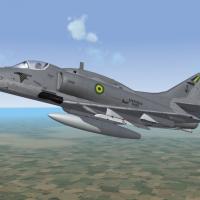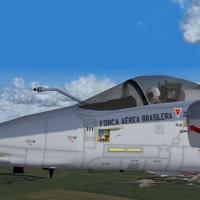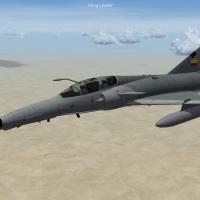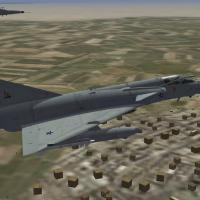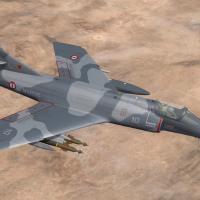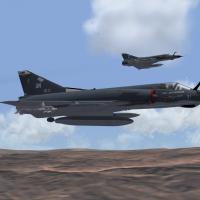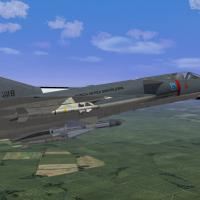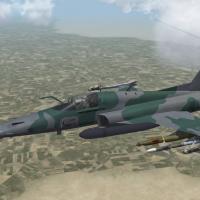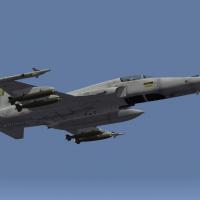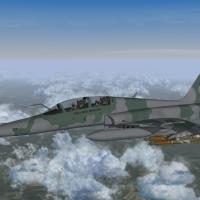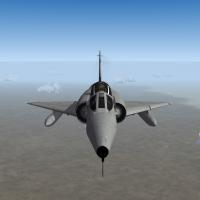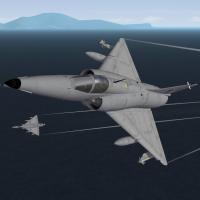-
Content count
583 -
Joined
-
Last visited
-
Days Won
26
Files posted by denissoliveira
-
AF-1 (A-4) Brazilian Navy
By denissoliveira in A-4
AF-1 Brazilian Navy
Marinha do Brasil
Strike Fighters 2 Full Merge or Strike Fighters 2 Israel
obs : AF-1.ini cockpit A-4 standart
213 downloads
-
AF-1 Brazilian Navy
By denissoliveira in A-4
AF-1 Brazilian Navy
Navy of Brazil
The Navy of Brazil has 23 copies of the version Skyhawk A-4KU, the last to be produced. Of these, 20 are single-seaters (version A-4KU) and 3 two-seaters training version (TA-4KU). These aircraft are used as single-seat five parts sources.
The single-seater model was designated AF-1 and AF-1A biposto.
The AF-1 and AF-1A were purchased in the late 90 Kuwaiti aircraft and are veterans of war, having participated in combat missions in Operation Desert Storm in early 1991. During the 1991 conflict with a camouflage flew in sand, brown and gray, in addition to taking the side of the fuselage written the words "Free Kuwait".
The Skyhawk Brazilians are based in Naval Air Station São Pedro Aldeia (BAeNSPA) and embedded operating in NAe São Paulo.
On 15/04/09 Embraer of Brazil and the Navy signed a $ 106 million for modernization nine AF-1 and AF-A three. The twelve A-4 Navy operating in Brazil must be retired in 2025.
Marinha do Brasil
A Marinha do Brasil possui 23 exemplares de Skyhawk da versão A-4KU, a última a ser produzida. Desses, 20 são monopostos (versão A-4KU) e 3 bipostos de treinamento (versão TA-4KU). Destas aeronaves, cinco monoplaces são utilizados como fontes de peças.
O modelo monoposto foi designado AF-1 e o biposto AF-1A.
Os AF-1 e AF-1A foram comprados no final dos anos 90 do Kuwait e são aeronaves veteranas de guerra, tendo participado de missões de combate da Operação Tempestade no Deserto no início de 1991. Durante o conflito de 1991 voaram com uma camuflagem em areia, marrom e cinza, além de levarem escrito na lateral da fuselagem as palavras "Free Kuwait".
Os Skyhawk brasileiros ficam sediados na Base Aérea Naval de São Pedro Aldeia (BAeNSPA) e operam embarcados no NAe São Paulo.
Em 15/04/09 a Embraer e a Marinha do Brasil assinaram um contrato de $106 milhões para modernização nove AF-1 e três AF-A. Os doze A-4 operacionais da Marinha do Brasil devem ser aposentados no ano de 2025.
(1 airplane and 1 ship)
Texture - Denis Oliveira
3D mod - Denis Oliveira
Decals - Denis Oliveira and PauloPanz
Data ini - Coupi, Denis Oliveira
Cockpit and Avioncs ini - Denis Oliveira
Hinchinbrooke for original CV
Good work Coupi !
509 downloads
-
AMX A-1A, AMX-T A-1B and AMX A-1M Brazilian Air Force
By denissoliveira in Other Origin
The AMX International AMX is a ground-attack aircraft for battlefield interdiction, close air support and reconnaissance missions. It was built until 1999 by AMX International, an Italian-Brazilian joint venture. The AMX is designated A-1 by the Brazilian Air Force, and A-11 Ghibli by the Italian Air Force.
The AMX is capable of operating at high subsonic speed and low altitude, by day or night, and if necessary, from bases with poorly equipped or damaged runways. Low IR signature and reduced radar equivalent cross-section help prevent detection, while low vulnerability of structure and systems aid survivability, while integrated ECM, air-to-air missiles and nose-mounted guns provide self-defence capabilities.
AMX-T
In 1986, development of a two-seat advanced trainer variant was undertaken. This was intended to provide trainee pilots with experience on fast jets, while still retaining the single-seater's attack capabilities. First flying in 1990, the AMX-T equipped both the Italian and Brazilian air forces.
A-1M
The product of a Brazilian upgrade program of their A-1s; significant features include a Mectron SCP-01 Scipio radar, Embraer BR2 data link, FLIR Systems navigation equipment, Elbit INS/GPS/databus, the adoption of a glass cockpit,[31] a new OBOGS system and HMD DASH IV.
O AMX International AMX, ou simplesmente AMX é um avião de ataque ar-superfície usado para missões de interdição, apoio aéreo aproximado e reconhecimento aéreo. Foi desenvolvido pelo consórcio internacional AMX Internacional. Na Força Aérea Brasileira, ele é designado A-1 (A-1A para a versão monoplace e A-1B para a versão de dois lugares). Com a modernização o A-1 passa a incorporar o M em sua designação na FAB, tornando-se então A-1M. Na Itália, ele tem o apelido de "Ghibli".
O AMX é capaz de operar em altas velocidades subsônicas a baixa altitude, tanto de dia quanto de noite, e se necessário, a partir de bases pouco equipadas ou com pistas danificadas. O caça conta com relativamente baixa assinatura em infravermelho e reduzida secção frontal ao radar, para melhorar seu percentual de sucesso nas missões. A auto-defesa é proporcionada por mísseis ar-ar, canhões integrados e sistemas de contramedidas eletrônicas
including:
Two versions of skin
Two fictitious skins (A-1M)
Three models:
AMX-1A
AMX-T A1B
AMX-1M
Model By Rafael Rodrigues
Texture By Denis Oliveira
1,049 downloads
-
Atlas Cheetah C Ecuador Air Force
By denissoliveira in Other Origin
Atlas Cheetah C Ecuador Air Force
Install - Need Update July 2012 and DLC Mirage IIIO
The Cheetah C was the ultimate development of the Cheetah series, and was the only fighter aircraft in service with the SAAF until replaced by the Saab JAS 39 Gripen in 2008. Many of the features of the Cheetah aircraft are still classified, and the SAAF is unwilling to reveal too many details. What is known is that in addition to the upgrades described above, the Cheetah C incorporates a more sophisticated avionics and navigation suite and a new pulse-doppler multi-mode radar (ELTA), both of which are regarded as being better than the systems fitted to Block 50 F-16s[citation needed], and one of the most advanced EW systems fitted to a fighter aircraft. The aircraft is also fitted with a data link, though the capabilities of this system are unknown, and it received updated versions of the helmet-mounted sight, HUD and improved HOTAS controls.
Other improvements include the fitting of a single-piece wrap-around windshield with an anti-radiation coating in place of the old three-piece version, a new in-flight refuelling probe with less external piping, new undercarriage and suspension, the deletion of the wing fences, an upgraded version of the Atar 9K50 and a new nose to incorporate the more sophisticated electronics and radar.
Like the Cheetah D, the Cheetah C is capable of delivering precision-guided munitions (PGMs), ranging from laser-guided bombs (LGBs), to GPS-guided weapons and TV-guided bombs. It also has the capability of using stand-off air-to-ground weapons such as the MUPSOW and TORGOS. In addition, it is able to carry a raft of air-to-air weapons, and the SAAF currently equips its aircraft with the V4 R-Darter, a beyond-visual-range (BVR) radar-guided missile, and the U-Darter, a highly capable short-range infrared (IR)-guided missile.
A measure of the capabilities of the Cheetah C is the result of an air-combat maneuvering (ACM) exercise between the Cheetah Cs of 2 Squadron and F-15E Strike Eagles of the 494th Fighter Squadron, United States Air Force at RAF Lakenheath, after which the score tallies for each side were almost exactly equal.
Now sold to the Equator.
Animed Cockpit - SHFT + 1
Modelo - TK (Mirage IIIO)
Texture - Denis Oliveira
Template Texture - Ludo
3D mod - Denis Oliveira
Decals - Denis Oliveira
Data ini - Coupi, Denis Oliveira
Cockpit and Avioncs ini - Coupi, MirageFactory
312 downloads
(5 reviews)0 comments
Updated
-
Atlas Cheetah C south african Air Force
By denissoliveira in Other Origin
Atlas Cheetah C south african Air Force
Install - Need Update July 2012 and DLC Mirage IIIO
The Cheetah C was the ultimate development of the Cheetah series, and was the only fighter aircraft in service with the SAAF until replaced by the Saab JAS 39 Gripen in 2008. Many of the features of the Cheetah aircraft are still classified, and the SAAF is unwilling to reveal too many details. What is known is that in addition to the upgrades described above, the Cheetah C incorporates a more sophisticated avionics and navigation suite and a new pulse-doppler multi-mode radar (ELTA), both of which are regarded as being better than the systems fitted to Block 50 F-16s[citation needed], and one of the most advanced EW systems fitted to a fighter aircraft. The aircraft is also fitted with a data link, though the capabilities of this system are unknown, and it received updated versions of the helmet-mounted sight, HUD and improved HOTAS controls.
Other improvements include the fitting of a single-piece wrap-around windshield with an anti-radiation coating in place of the old three-piece version, a new in-flight refuelling probe with less external piping, new undercarriage and suspension, the deletion of the wing fences, an upgraded version of the Atar 9K50 and a new nose to incorporate the more sophisticated electronics and radar.
Like the Cheetah D, the Cheetah C is capable of delivering precision-guided munitions (PGMs), ranging from laser-guided bombs (LGBs), to GPS-guided weapons and TV-guided bombs. It also has the capability of using stand-off air-to-ground weapons such as the MUPSOW and TORGOS. In addition, it is able to carry a raft of air-to-air weapons, and the SAAF currently equips its aircraft with the V4 R-Darter, a beyond-visual-range (BVR) radar-guided missile, and the U-Darter, a highly capable short-range infrared (IR)-guided missile.
A measure of the capabilities of the Cheetah C is the result of an air-combat maneuvering (ACM) exercise between the Cheetah Cs of 2 Squadron and F-15E Strike Eagles of the 494th Fighter Squadron, United States Air Force at RAF Lakenheath, after which the score tallies for each side were almost exactly equal.
Animed Cockpit - SHFT + 1
Modelo - TK (Mirage IIIO)
Texture - Denis Oliveira
Template Texture - Ludo
3D mod - Denis Oliveira
Decals - Denis Oliveira
Data ini - Coupi, Denis Oliveira
Cockpit and Avioncs ini - Coupi, MirageFactory
501 downloads
(4 reviews)0 comments
Updated
-
Atlas Cheetah D
By denissoliveira in Other Origin
Atlas Cheetah D
The Cheetah C was the ultimate development of the Cheetah series, and was the only fighter aircraft in service with the SAAF until replaced by the Saab JAS 39 Gripen in 2008. Many of the features of the Cheetah aircraft are still classified, and the SAAF is unwilling to reveal too many details. What is known is that in addition to the upgrades described above, the Cheetah C incorporates a more sophisticated avionics and navigation suite and a new pulse-doppler multi-mode radar (ELTA), both of which are regarded as being better than the systems fitted to Block 50 F-16s[citation needed], and one of the most advanced EW systems fitted to a fighter aircraft. The aircraft is also fitted with a data link, though the capabilities of this system are unknown, and it received updated versions of the helmet-mounted sight, HUD and improved HOTAS controls.
Other improvements include the fitting of a single-piece wrap-around windshield with an anti-radiation coating in place of the old three-piece version, a new in-flight refuelling probe with less external piping, new undercarriage and suspension, the deletion of the wing fences, an upgraded version of the Atar 9K50 and a new nose to incorporate the more sophisticated electronics and radar.
Like the Cheetah D, the Cheetah C is capable of delivering precision-guided munitions (PGMs), ranging from laser-guided bombs (LGBs), to GPS-guided weapons and TV-guided bombs. It also has the capability of using stand-off air-to-ground weapons such as the MUPSOW and TORGOS. In addition, it is able to carry a raft of air-to-air weapons, and the SAAF currently equips its aircraft with the V4 R-Darter, a beyond-visual-range (BVR) radar-guided missile, and the U-Darter, a highly capable short-range infrared (IR)-guided missile.
A measure of the capabilities of the Cheetah C is the result of an air-combat maneuvering (ACM) exercise between the Cheetah Cs of 2 Squadron and F-15E Strike Eagles of the 494th Fighter Squadron, United States Air Force at RAF Lakenheath, after which the score tallies for each side were almost exactly equal.
Included 3 models:
-Cheetah D Early
-Cheetah D Late
-Cheetah D FAE (ecuator)
Requirements: DLC Mirage IIIO
Texture Temp by Ludo.m54
Texture - Denis Oliveira
3D mod - Denis Oliveira
Decals - Coupi
Data ini - Coupi
Cockpit and Avioncs ini - Coupi
385 downloads
-
Atlas Cheetah E south african Air Force
By denissoliveira in Other Origin
Atlas Cheetah E south african Air Force
Install - Need Update July 2012 and DLC Mirage IIIO
The single-seater Cheetah E is regarded by most observers[who?] as having just been an interim fighter for use in the period before the Cheetah Cs became operational, due to the very short operational life of the Cheetah E, which was only a few years from its entry into operational service in 1987/88 to its retirement in 1992. It was fitted with a comparatively simple avionics suite and radar, and retained the Atar 9C-3 engine. Its typical mission while in service was as a standby interceptor, whereby a minimum of two aircraft, armed with two V3B (later V3C) missiles, would be on permanent alert status in case of an attack from the north.
All the aircraft were placed into storage, though the final example, No.842, was painted in a non-standard camouflage scheme and used for systems testing. No.842 is currently with the SAAF Museum, and is stored at AFB Swartkop. In 2003 Chile purchased five of the mothballed aircraft, numbers 819, 820, 827, 832 and 833. The country has also indicated its desire to purchase seven more aircraft (numbers 822, 823, 825, 828, 829, 831 and 834), subject to the agreement of a suitable purchase price. The Chilean Air Force (FACh) will use the Cheetah E airframes as a source of spares for its similar ENAER Pantera aircraft.
Animed Cockpit - SHFT + 1
Modelo - TK (Mirage IIIO)
Texture - Denis Oliveira
Template Texture - Ludo
3D mod - Denis Oliveira
Decals - Denis Oliveira
Data ini - Coupi, Denis Oliveira
Cockpit and Avioncs ini - ace888
337 downloads
(2 reviews)0 comments
Updated
-
Dassault Étendard IVM/IVP
By denissoliveira in Other
Dassault Étendard IVM/IVP
Etendard IV was like its predecessors a light attack aircraft. In 1956, this unit interests Navy as an embedded multi-role fighter. In December 1956, a semi-navalized prototype is controlled. In May 1957, 5 copies of fully navalized pre-production are controlled by the Navy, which gets its name from Etendard IVM. The first prototype took place May 21, 1958, and the first pre-series will follow on December 21 the same year. Both devices are powered by a SNECMA Atar 08B thrust of 4.4 tonnes. pre-production copies provided with tips of folding wings, the landing gear to be strengthened and the catapult and arrested a drag hook. The second copy of preproduction was pushed by a Rolls-Royce Avon 51 5 tons of thrust, he carried a camera in the nose and was named Etendard IVP (used for tactical reconnaissance). Between 1963 and 1965, 69 Etendard IVM and 21 PVI were delivered to the French air arm, they remained in service until 1991, when they were replaced by the Super-Etendard.
Original 3D model by Bobrock (Giuseppe Valfrè)
Templates by 7eleven & Ludo.m54
Texture and Decals - PauloPanz
Data.ini and cockpit.ini - Coupi
Special gratefulness to Coupi, paulopanz and 7eleven.
Thank Coupi and paulopanz for this and other projects we participate.
770 downloads
-
Dassault Super Etendard Pak
By denissoliveira in Other
Dassault Super Etendard Pak (SEM)
For SF2, Any & All (Full-4 Merged Prefered)
The Super Etendard is a carrier-based single-seat strike fighter first introduced into service in 1978. It is an updated version of the Etendard IVM. Based on experience gained during the Korean war (1950-53), French authorities drew up specifications for a light interceptor. This definition was rapidly assimilated into a program for a light tactical bomber that could also fulfil an air superiority mission. At the same time, NATO published its requirements for the LWTSF (Light Weight Tactical Strike Fighter). In response, the Dassault company presented its Mirage and Etendard aircraft.
Package includes:
Super Etendard;
Super Etendard SEM 1;
Super Etendard SEM 2;
Super Etendard SEM 3;
Super Etendard SEM 4;
Super Etendard SEM 5;
Super Etendard Iraq;
Super Etendard Argentine Navy;
5 skins;
Adjusted weapons loadouts.
Super Etendard by foxmonter.
Texture and decals modification - denis oliveira , FRPignon.
Template texture - FLOGGER23.
Cockpit modification - FRPignon.
Raven_claws 2.0 weapon pack.
1,559 downloads
- dassault
- super etendard
- (and 1 more)
-
Dassault-Breguet Super Étendard
By denissoliveira in Other
The Dassault-Breguet Super Étendard
The Dassault-Breguet Super Étendard (Étendard is French for "battle flag") is a French carrier-borne strike fighter aircraft designed by Dassault-Breguet for service with the French Navy. The aircraft is an advanced development of the Étendard IVM. The Super Étendard first flew in October 1974 and entered French service in June 1978. French Super Étendards have served in several conflicts such as the Kosovo war, the war in Afghanistan and the military intervention in Libya.
The Super Étendard was also operated by Iraq and Argentina, who both deployed the aircraft during wartime. The Super Étendard was used by Iraq to attack oil tankers and merchant shipping in the Persian Gulf during the Iraq-Iran War. Argentina's use of the Super Étendard and the Exocet missile during the 1982 Falklands War led to the aircraft gaining considerable popular recognition. In French service, the Super Étendard was replaced by the Dassault Rafale in 2016.
Super Étendard in the Falklands War
The naval aviation, suffering an arms embargo since 1978 by US President Jimmy Carter for human rights abuses, was in the middle of the process of replacing their A-4Q Skyhawks with French-built Dassault-Breguet Super Étendards. Although only five aircraft were delivered by the time of the conflict, the service became famous worldwide when they used their AM39 Exocet anti-shipping missiles, also purchased from France, to sink the Royal Navy's HMS Sheffield and the support ship Atlantic Conveyor. The older A-4Qs also had a role destroying HMS Ardent.
Obs:
(Use crt + = to hide the joystick, and ctr + - to return)
Original 3D model(Étendard) by Bobrock (Giuseppe Valfrè)
Templates Texture by Ludo.m54 & 7eleven
Model(Super Étendard) - DenisOliveira
Texture and Decals - PauloPanz
Data.ini and cockpit.ini - Coupi
Special gratefulness to Coupi, paulopanz and 7eleven.
Thank Coupi and paulopanz for this and other projects we participate.
916 downloads
-
Embraer EMB 314 Super Tucano (Beta)
By denissoliveira in Other Origin
The Embraer EMB 314 Super Tucano , also named ALX or A-29, is a Brazilian turboprop light attack aircraftdesigned and built by Embraer as a development of the Embraer EMB 312 Tucano.
He needs a new FM, he is not flying well.
652 downloads
-
Embraer Tucano 3Ds Max
By denissoliveira in Utilities / Editors
Prohibited the sale.
Do whatever it wants the file, but please send your project to me.
I do not have time to finish.
98 downloads
-
F-103 Mirage IIIEBR
By denissoliveira in Mirage 3
F-103 Mirage IIIEBR Brazilian Air Force
Modelo - TK (MIrage IIIO)
Texture - TK, Denis Oliveira
Canard - Denis Oliveira
Install - Need Update July 2012 and DLC Mirage IIIO
185 downloads
-
F-103 Mirage IIIEBR (Version 1.0.1)
By denissoliveira in Mirage 3
BRAZILIAN AIR FORCE
F-103 Mirage IIIEBR
Model: Mirage Factory
Texture: Denis Oliveira
To correct weapons and effects add :
Mirage 5F(Weapons - http://combatace.com...0873-mirage-5f/), Mirage Factory weapons and Mirage´s Addons (Mirage Factory)
235 downloads
-
F-103 Mirage IIIEBR Brazilian Air Force (refuelling probe)
By denissoliveira in Mirage 3
F-103 Mirage IIIEBR Brazilian Air Force (refuelling probe)
Install - Need Update July 2012, DLC Mirage IIIO and DLC Mirage IIIEL
The F-103 Mirage IIIEBR represented a tremendous leap to the Brazilian Air Force, being over thirty years of service and more than 65,000 flying hours.
The versions of Mirage III acquired by FAB were developed primarily for air defense missions, but keep some capacity to act as platforms for ground attack.
The engine was a SNECMA ATAR 09C, whose maximum thrust with afterburning reached 13,900 pounds (6305 kg), leading the aircraft a maximum speed of Mach 2.2 (2,350 km / h).
The fire control system was based on radar Thomson-CSF Cyrano II, which originally operated the integrated air-to-air missile infrared Matra R530, later replaced by Israeli missile Python III.
As arms fixed, the aircraft was equipped with two 30 mm DEFA. For navigation, the Mirage III FAB type Doppler systems used. In the early '90s, the FAB joined the Squadron's missions Jaguar air-ground attack, starting to use free-fall bombs and rocket launchers.
Upgrading the F-103
In 1989 all F-103s entered a limited upgrade program. The upgrade consisted of the installation of canards and some minor mechanical and structural modifications. In 1991/1992 one F-103E (FAB 4929) received a refuelling probe installation and on April 22, 1992, the aircraft made its first refuelling contact with a KC-130H of the 1º/1º GT. The modified F-103 flew until 1993 but was then retired and the program to install refuelling probes on all Mirage fleet was cancelled.(The number FAB-4928, FAB-4930 and FAB-4931 are fictitious!)
(Portuguese)__________________________________________________________________________________
O F-103 Mirage IIIEBR representou um tremendo salto para a Força Aérea Brasileira, ficando mais de trinta anos de serviço e voando mais de 65.000 horas.
Os Mirage III das versões adquiridas pela FAB foram desenvolvidas primariamente para missões de defesa aérea, embora mantivessem alguma capacidade de atuar como plataformas de ataque ao solo.
O motor era um SNECMA ATAR 09C, cujo empuxo máximo com pós-combustão alcançava 13.900 libras (6.305 kg), levando a aeronave a velocidade máxima de Mach 2,2 (2.350 km/h).
O sistema de controle de fogo era baseado no radar Thomson-CSF Cyrano II, que originalmente operava integrado ao míssil ar-ar infra-vermelho Matra R530, depois substituído pelo míssil israelense Python III.
Como armamento fixo, a aeronave era dotada de dois canhões DEFA de 30 mm. Para navegação, os Mirage III da FAB utilizavam sistemas tipo Doppler. No inícios dos anos 90, a FAB incorporou ao Esquadrão Jaguar as missões de ataque ar-solo, passando a utilizar bombas de queda livre e lançadores de foguetes.
Atualizando o F-103
Em 1989, todos os F-103 entrou em um programa de atualização limitado. O melhoramento consiste na instalação de canards e algumas modificações mecânicas e estruturais menores. Em 1991/1992 um F-103E (FAB 4929), recebeu uma instalação de sonda de reabastecimento e, em 22 de abril de 1992, a aeronave fez o seu primeiro contato com um reabastecimento KC-130H do 1 º / 1 º GT. A modificação F-103 voaram até 1993, mas foi então aposentado e o programa para instalar sondas de reabastecimento em toda frota de Mirage foi cancelado. (Os número FAB-4928, FAB-4930 e FAB-4931 são fictícios !)
Animed Cockpit - SHFT + 1
Modelo - TK (Mirage IIIO)
Texture - TK, Denis Oliveira
mod - Denis Oliveira
Decals - Denis Oliveira
Data.ini - Denis Oliveira, Coupi
160 downloads
(3 reviews)0 comments
Updated
-
F-103 Mirage IIIEBR Brazilian Air Force V.2.0
By denissoliveira in Mirage 3
F-103 Mirage IIIEBR Brazilian Air Force
Version 2
Install - Need Update July 2012 and DLC Mirage IIIO
The F-103 Mirage IIIEBR represented a tremendous leap to the Brazilian Air Force, being over thirty years of service and more than 65,000 flying hours.
The versions of Mirage III acquired by FAB were developed primarily for air defense missions, but keep some capacity to act as platforms for ground attack.
The engine was a SNECMA ATAR 09C, whose maximum thrust with afterburning reached 13,900 pounds (6305 kg), leading the aircraft a maximum speed of Mach 2.2 (2,350 km / h).
The fire control system was based on radar Thomson-CSF Cyrano II, which originally operated the integrated air-to-air missile infrared Matra R530, later replaced by Israeli missile Python III.
As arms fixed, the aircraft was equipped with two 30 mm DEFA. For navigation, the Mirage III FAB type Doppler systems used. In the early '90s, the FAB joined the Squadron's missions Jaguar air-ground attack, starting to use free-fall bombs and rocket launchers.
(Portuguese)
O F-103 Mirage IIIEBR representou um tremendo salto para a Força Aérea Brasileira, ficando mais de trinta anos de serviço e voando mais de 65.000 horas.
Os Mirage III das versões adquiridas pela FAB foram desenvolvidas primariamente para missões de defesa aérea, embora mantivessem alguma capacidade de atuar como plataformas de ataque ao solo.
O motor era um SNECMA ATAR 09C, cujo empuxo máximo com pós-combustão alcançava 13.900 libras (6.305 kg), levando a aeronave a velocidade máxima de Mach 2,2 (2.350 km/h).
O sistema de controle de fogo era baseado no radar Thomson-CSF Cyrano II, que originalmente operava integrado ao míssil ar-ar infra-vermelho Matra R530, depois substituído pelo míssil israelense Python III.
Como armamento fixo, a aeronave era dotada de dois canhões DEFA de 30 mm. Para navegação, os Mirage III da FAB utilizavam sistemas tipo Doppler. No inícios dos anos 90, a FAB incorporou ao Esquadrão Jaguar as missões de ataque ar-solo, passando a utilizar bombas de queda livre e lançadores de foguetes.
Animed Cockpit - SHFT + 1
Modelo - TK (Mirage IIIO)
Texture - TK, Denis Oliveira
mod - Denis Oliveira
Decals - Coupi
Data.ini - Denis Oliveira, Coupi
178 downloads
(3 reviews)0 comments
Updated
-
F-103E and F-103D - Mirage III Brazilian Air Force PACK
By denissoliveira in Mirage 3
F-103 Mirage III Brazilian Air Force
Install - Need Update July 2012, DLC Mirage IIIO (DLC Mirage IIIEL optional cockpit)
History
The history of the Mirage III in Brazil goes back to the sixties, when the FAB elaborated a modernization program and the creation of an air space control system. In 1967 the implementation started of the SISDACTA- Sistema Integrado de Defesa Aérea e Controle de Tráfego Aéreo (Integrated Air Traffic Control and Air Defence System) and of the COMDA-Comando de Defesa Aérea (Air Defence Command).
As part of the program, it was necessary to acquire a supersonic aircraft to execute the air defence and interception missions. The FAB's initial desire was to obtain the McDonnell Douglas F-4 Phantom II, however it could not be materialised because of American restrictions on the sale of advanced military equipment to South American countries.
With the Phantom out of the game, the remaining option was to look for an European fighter. Among the contenders were the British English Electric Lightning, the Swedish Saab Draken and the French Dassault-Breguet Mirage IIIE. About the same time, the Mirage IIIC, in the hands of the Israeli pilots, inflicted heavy losses to its Arabic neighbours in the 'Six Day War'. There is no doubt that the Mirage III's excellent performance, achieved by the Israelis in that war, helped Dassault-Breguet secure many clients around the world, including Brazil.
Operational Career
On April 11, 1979, the 1º GDA ( Primeiro Grupo de Defesa Aérea – First Air Defence Group) was officially established. On April 19, 1979, the 1º ALADA was disbanded and the 1º GDA took over its functions and F-103 aircraft. The 1º GDA remained stationed at Anápolis AB.
During its operational career in Brazil, the Mirage III fleet suffered some attrition and many additional airframes were bought to replace the lost ones and to keep up the 1º GDA's combat readiness. In total, Brazil acquired 16 additional aircraft from Armée de L’Air surplus. These consisted of four F-103E in 1980, two F-103D in 1984, two F-103E in 1988, two F-103D and two F-103E in 1989, two F-103E in 1998 and the last two F-103D in 1999.
The F-103 Mirage IIIEBR represented a tremendous leap to the Brazilian Air Force, being over thirty years of service and more than 65,000 flying hours.
The versions of Mirage III acquired by FAB were developed primarily for air defense missions, but keep some capacity to act as platforms for ground attack.
The engine was a SNECMA ATAR 09C, whose maximum thrust with afterburning reached 13,900 pounds (6305 kg), leading the aircraft a maximum speed of Mach 2.2 (2,350 km / h).
The fire control system was based on radar Thomson-CSF Cyrano II, which originally operated the integrated air-to-air missile infrared Matra R530, later replaced by Israeli missile Python III.
As arms fixed, the aircraft was equipped with two 30 mm DEFA. For navigation, the Mirage III FAB type Doppler systems used. In the early '90s, the FAB joined the Squadron's missions Jaguar air-ground attack, starting to use free-fall bombs and rocket launchers.
(Portuguese)
História
A história do Mirage III no Brasil remonta à década de sessenta, quando a FAB elaborou um programa de modernização e criação de um sistema de controle do espaço aéreo. Em 1967, a implementação começou da SISDACTA- Sistema Integrado de Defesa Aérea e Controle de Tráfego Aéreo (Air Traffic Control Integrado e Air Sistema de Defesa) e do COMDA-Comando de Defesa Aérea (Comando de Defesa Aérea).
Como parte do programa, foi necessário adquirir um avião supersônico para executar as missões de defesa aérea e interceptação. Desejo inicial da FAB foi obter a McDonnell Douglas F-4 Phantom II, no entanto, ele não poderia ser materializado por causa das restrições americanas sobre a venda de equipamento militar avançado para os países da América do Sul.
Com o Fantasma fora do jogo, a opção restante era procurar um lutador europeu. Entre os contendores foram o Inglês Britânico elétrico do relâmpago, a sueca Saab Draken e os franceses Dassault-Breguet Mirage IIIE. Quase ao mesmo tempo, o Mirage IIIC, nas mãos dos pilotos israelenses, infligiu pesadas perdas para os seus vizinhos árabes na 'Guerra dos Seis Dias ". Não há dúvida de que o excelente desempenho do Mirage III, alcançada pelos israelenses em que a guerra, ajudou a Dassault-Breguet garantir muitos clientes ao redor do mundo, incluindo o Brasil.
Carreira Operacional
Em 11 de abril de 1979, o 1º GDA (Primeiro Grupo de Defesa Aérea - First Air Grupo de Defesa) foi criada oficialmente. Em 19 de abril de 1979 a 1º ALADA foi dissolvida e o 1º GDA assumiu suas funções e aeronaves F-103. O 1º GDA permaneceu estacionada em Anápolis AB.
Durante a sua carreira operacional no Brasil, a frota de Mirage III sofrido algum desgaste e muitas fuselagens adicionais foram comprados para substituir os perdidos e para manter a prontidão de combate do 1º GDA. No total, o Brasil adquiriu 16 aeronaves adicionais a partir do excedente Armée de L'Air. Estes consistiram de quatro F-103E, em 1980, dois F-103D em 1984, dois F-103E, em 1988, dois F-103D e dois F-103E, em 1989, dois F-103E em 1998 e os dois últimos F-103D em de 1999.
O F-103 Mirage IIIEBR representou um tremendo salto para a Força Aérea Brasileira, ficando mais de trinta anos de serviço e voando mais de 65.000 horas.
Os Mirage III das versões adquiridas pela FAB foram desenvolvidas primariamente para missões de defesa aérea, embora mantivessem alguma capacidade de atuar como plataformas de ataque ao solo.
O motor era um SNECMA ATAR 09C, cujo empuxo máximo com pós-combustão alcançava 13.900 libras (6.305 kg), levando a aeronave a velocidade máxima de Mach 2,2 (2.350 km/h).
O sistema de controle de fogo era baseado no radar Thomson-CSF Cyrano II, que originalmente operava integrado ao míssil ar-ar infra-vermelho Matra R530, depois substituído pelo míssil israelense Python III.
Como armamento fixo, a aeronave era dotada de dois canhões DEFA de 30 mm. Para navegação, os Mirage III da FAB utilizavam sistemas tipo Doppler. No inícios dos anos 90, a FAB incorporou ao Esquadrão Jaguar as missões de ataque ar-solo, passando a utilizar bombas de queda livre e lançadores de foguetes.
Special thanks to Paulopanz and Coupi.
Mirage IIIEBR (3 textures and 1 silver texture)
Mirage IIIEBR (fictitious - fuel probe test in 1990-93)
Mirage IIIDRB (late and Early)
Modelo - TK (Mirage IIIO)
Texture - Ludo, Denis Oliveira
mod - Denis Oliveira
Decals - Paulopanz
Data.ini - Denis Oliveira, Coupi
324 downloads
-
F-103E Mirage IIIEBR Brazilian Air Force
By denissoliveira in Mirage 3
F-103 Mirage IIIEBR Brazilian Air Force
Version 3
(two versions included)
Install - Need Update July 2012, DLC Mirage IIIO and DLC Mirage IIIEL
The F-103 Mirage IIIEBR represented a tremendous leap to the Brazilian Air Force, being over thirty years of service and more than 65,000 flying hours.
The versions of Mirage III acquired by FAB were developed primarily for air defense missions, but keep some capacity to act as platforms for ground attack.
The engine was a SNECMA ATAR 09C, whose maximum thrust with afterburning reached 13,900 pounds (6305 kg), leading the aircraft a maximum speed of Mach 2.2 (2,350 km / h).
The fire control system was based on radar Thomson-CSF Cyrano II, which originally operated the integrated air-to-air missile infrared Matra R530, later replaced by Israeli missile Python III.
As arms fixed, the aircraft was equipped with two 30 mm DEFA. For navigation, the Mirage III FAB type Doppler systems used. In the early '90s, the FAB joined the Squadron's missions Jaguar air-ground attack, starting to use free-fall bombs and rocket launchers.
(Portuguese)
O F-103 Mirage IIIEBR representou um tremendo salto para a Força Aérea Brasileira, ficando mais de trinta anos de serviço e voando mais de 65.000 horas.
Os Mirage III das versões adquiridas pela FAB foram desenvolvidas primariamente para missões de defesa aérea, embora mantivessem alguma capacidade de atuar como plataformas de ataque ao solo.
O motor era um SNECMA ATAR 09C, cujo empuxo máximo com pós-combustão alcançava 13.900 libras (6.305 kg), levando a aeronave a velocidade máxima de Mach 2,2 (2.350 km/h).
O sistema de controle de fogo era baseado no radar Thomson-CSF Cyrano II, que originalmente operava integrado ao míssil ar-ar infra-vermelho Matra R530, depois substituído pelo míssil israelense Python III.
Como armamento fixo, a aeronave era dotada de dois canhões DEFA de 30 mm. Para navegação, os Mirage III da FAB utilizavam sistemas tipo Doppler. No inícios dos anos 90, a FAB incorporou ao Esquadrão Jaguar as missões de ataque ar-solo, passando a utilizar bombas de queda livre e lançadores de foguetes.
Animed Cockpit - SHFT + 1
Modelo - TK (Mirage IIIO)
Texture - TK, Denis Oliveira
mod - Denis Oliveira
Decals - Coupi
Data.ini - Denis Oliveira, Coupi
173 downloads
(5 reviews)0 comments
Updated
-
F-5E and F-5EM Tigre Brazilian Air Force (Pack)
By denissoliveira in F-5
F-5 Tigre Brazilian Air Force (Pack)
The Tiger in Brazil
In Brazil, the history of the F-5 started in practice in March 1975, however, he was quoted to equip the FAB since 1965, in its version F-5A / B. In 1967, he was again contemplated, this time as a design vector SISDACTA. The preference was for the F-4 Phantom, but this was vetoed by the Americans, who in turn offered the F-5C (version proposed by Northrop with improvements based on the evaluation report made in Vietnam).
The impasse U.S. favored the French, having acquired the FAB 16 Dassault Mirage III. A new international contest held in 1971 to replace the AT-33A, attended the Fiat G-91, MB-326K, Harrier Mk-50, Jaguar GR1 and A-4F, won by Northrop fighter now in his version F-5E. Began a long and successful history of the Tiger II in FAB, which still continues today and is expected to last until 2018. The FAB received six F-5B (FAB 4800-4805), 4 F-5F (FAB 4806-4809) and 58 F-5E (FAB 4820-4877) that were acquired in two separate batches. The first batch in 1973, factory direct (06 F + 36 F-5B-5D), the value of $ 115 million and the second batch in 1988, former USAF (04 F-22 F-5F and 5E), the total cost of $ 13.1 million. The first aircraft of "Operation Tiger", became known as the transfer of the first batch were delivered from February 28, 1975 in Palmdale. Were three F-5B, which arrived in Brazil on 06 March of the same year, followed by another three F-5B on 13 May. On June 12, 1975, came the first 4 F-5E to BAGL, starting an airlift that ended on February 12 of the following year, totaling 36 aircraft.
In 1985, after much searching, we reached an agreement with the Reagan administration, which agreed to negotiate 4 F-5F and 22 F-5E, which would come from the ranks of the USAF, at a cost of $ 13.1 million, a trifle. Around September 2006, it was speculated acquisition of 9 aircraft F-5E Tiger II, used in Saudi Arabia, 6 F-5E and F-5F 3. This purchase, however, went no further, come to the Brazilian Air Force to acquire a lot of aircraft of the Royal Jordanian Air Force. In total 11 aircraft were purchased, and 8 single-seat F-5E and F-5F 3 seaters. The first aircraft coming from Jordan arrived in Brazil on August 19, 2008 and were sent to the Air Force Material Park of São Paulo (PAMA-SP). All the F-5 ex-Jordan should be converted to the standard F-and F-5FM 5EM.
4 Planes, 3 models and 3 Skins
- F-5E Tigre II
- F-5E Tigre II "Ex-Aggressor"
- F-5EM Tigre II "Ex-Aggressor"
- F-5EM Tigre II
(Included but the Old F-5E "F-5EM 4856 Ex-Aggressor")
________________________________________________________________________________________
O Tigre no Brasil
No Brasil, a história do F-5 iniciou na prática em março de 1975, porém, ele esteve cotado para equipar a FAB desde 1965, em sua versão F-5A/B. Em 1967, ele foi novamente cogitado, desta vez como vetor do projeto SISDACTA. A preferência era para o F-4 Phantom, mas este foi vetado pelos americanos, que em contrapartida ofereceram o F-5C (versão proposta pela Northrop com melhorias baseadas no relatório de avaliação feito no Vietnã).
O impasse norte-americano favoreceu os franceses, tendo a FAB adquirido 16 Dassault Mirage III. Numa nova disputa internacional, realizada a partir de 1971 para substituir os AT-33A, na qual participaram o Fiat G-91, MB-326K, Harrier Mk-50, Jaguar GR1 e A-4F, saiu vencedor o caça da Northrop, agora em sua versão F-5E. Começava a longa história de sucesso do Tiger II na FAB, que continua até hoje e ainda deve durar até 2018. A FAB recebeu 6 F-5B (FAB 4800 a 4805), 4 F-5F (FAB 4806 a 4809) e 58 F-5E (FAB 4820 a 4877) que foram adquiridos em dois lotes distintos. O primeiro lote em 1973, direto da fábrica (06 F-5B + 36 F-5E), ao valor de US$ 115 milhões e o segundo lote, em 1988, ex-USAF (04 F-5F e 22 F-5E), ao custo total de US$ 13,1 milhões. As primeiras aeronaves da "Operação Tigre", como ficou conhecido o translado do primeiro lote, foram entregues a partir de 28 de fevereiro de 1975 em Palmdale. Eram 3 F-5B, que chegaram ao Brasil no dia 06 de março do mesmo ano, sendo seguidos de outros 3 F-5B em 13 de maio. Em 12 de junho de 1975, chegavam os primeiros 4 F-5E à BAGL, dando início a uma ponte aérea que só terminaria em 12 de fevereiro do ano seguinte, totalizando 36 aeronaves.
Em 1985, depois de muito procurar, chegou-se a um acordo com o governo Reagan, que aceitou negociar 4 F-5F e 22 F-5E, que sairiam das fileiras da USAF, a um custo de US$ 13,1 milhões, uma bagatela. Por volta de Setembro de 2006, especulava-se a aquisição de 9 aeronaves F-5E Tiger II, usadas da Arábia Saudita, sendo 6 F-5E e 3 F-5F. Esta compra, entretanto, não foi adiante, vindo a Força Aérea Brasileira a adquirir um lote de aeronaves pertencentes à Real Força Aérea da Jordânia. No total foram compradas 11 aeronaves, sendo 8 F-5E monoplaces e 3 F-5F biplaces. As primeiras aeronaves vindas da Jordânia chegaram no Brasil em 19 agosto de 2008 e foram enviadas ao Parque de Material da Aeronáutica de São Paulo (PAMA-SP). Todas os F-5 ex-Jordânia deverão ser convertidos para o padrão F-5EM e F-5FM.
4 Planes, 3 models and 3 Skins (Incluido o mas Antigo F-5E "F-5EM 4856 ex-Aggressor")
CREDITS:
- Texture - PauloPanz, Denis Oliveira
- 3D mod - Denis Oliveira
- Decals - PauloPanz, Denis Oliveira
- Data ini - PauloPanz, Denis Oliveira
- Cockpit and Avioncs ini - Coupi
- F/A-18A Cockpit-Brain32
- F/A-18A Avionics-Crusader e CrazyhorseB34
- Boz for temps
- Mike 1 for original SF-1 great skins.
- Soulfreak for FAB Grey one
- The Mirage Factory for the plane (original readmes in proper folder)
- Sony Tucson & Boz for temps (mixed and edited)
- Mike 1 for original NVAF & VPAF skins
- Eburger 68 for data.ini edits in Viet pack
900 downloads
-
F-5E Tigre Brazilian Air Force
By denissoliveira in F-5
F-5E Tigre Brazilian Air Force (v.2.0)
required F-5E Early Versions Pack 1.0 (cockipt and decals) to keep the original files and credits.
http://combatace.com/files/file/15116-f-5e-early-versions-pack/
I had problem with afterburner, so this using the stock files.
F-5 Tigre Brazilian Air Force
The Tiger in Brazil
In Brazil, the history of the F-5 started in practice in March 1975, however, he was quoted to equip the FAB since 1965, in its version F-5A / B. In 1967, he was again contemplated, this time as a design vector SISDACTA. The preference was for the F-4 Phantom, but this was vetoed by the Americans, who in turn offered the F-5C (version proposed by Northrop with improvements based on the evaluation report made in Vietnam).
The impasse U.S. favored the French, having acquired the FAB 16 Dassault Mirage III. A new international contest held in 1971 to replace the AT-33A, attended the Fiat G-91, MB-326K, Harrier Mk-50, Jaguar GR1 and A-4F, won by Northrop fighter now in his version F-5E. Began a long and successful history of the Tiger II in FAB, which still continues today and is expected to last until 2018. The FAB received six F-5B (FAB 4800-4805), 4 F-5F (FAB 4806-4809) and 58 F-5E (FAB 4820-4877) that were acquired in two separate batches. The first batch in 1973, factory direct (06 F + 36 F-5B-5D), the value of $ 115 million and the second batch in 1988, former USAF (04 F-22 F-5F and 5E), the total cost of $ 13.1 million. The first aircraft of "Operation Tiger", became known as the transfer of the first batch were delivered from February 28, 1975 in Palmdale. Were three F-5B, which arrived in Brazil on 06 March of the same year, followed by another three F-5B on 13 May. On June 12, 1975, came the first 4 F-5E to BAGL, starting an airlift that ended on February 12 of the following year, totaling 36 aircraft.
In 1985, after much searching, we reached an agreement with the Reagan administration, which agreed to negotiate 4 F-5F and 22 F-5E, which would come from the ranks of the USAF, at a cost of $ 13.1 million, a trifle. Around September 2006, it was speculated acquisition of 9 aircraft F-5E Tiger II, used in Saudi Arabia, 6 F-5E and F-5F 3. This purchase, however, went no further, come to the Brazilian Air Force to acquire a lot of aircraft of the Royal Jordanian Air Force. In total 11 aircraft were purchased, and 8 single-seat F-5E and F-5F 3 seaters. The first aircraft coming from Jordan arrived in Brazil on August 19, 2008 and were sent to the Air Force Material Park of São Paulo (PAMA-SP). All the F-5 ex-Jordan should be converted to the standard F-and F-5FM 5EM.
CREDITS:
Bpao and Mirage Factory crew: Orginal F-5E model and templates
FastCargo for original F-5F model
EricJ and pappychecksix for original F-5F templates and textures
Sophocles for his superb cockpit work. Every switch is a work of art.
Crusader for his ini file magic, really makes the cockpit and plane come alive.
Paulo for his mammoth decaling work which he allowed me to use. and even helped me by reworking some of it.
Me for cobbling all this together (=texturing and modeling work)
The rest of the Combat Ace community. Without you guys I would never have bothered to make it this far.
Denis: update Skins and mod (fuelProbe)
454 downloads
-
F-5F and F-5FM Brazilian Air Force
By denissoliveira in F-5
The Northrop F-5A/B Freedom Fighter and the F-5E/F Tiger II are part of a family of supersonic Light fighter, initially designed in the late 1950s by Northrop Corporation. Being smaller and simpler than contemporaries such as the McDonnell Douglas F-4 Phantom II, the F-5 cost less to both procure and operate, making it a popular export aircraft. The F-5 started life as a privately funded light fighter program by Northrop in the 1950s. The design team wrapped a small, highly aerodynamic fighter around two compact and high-thrust General Electric J85 engines, focusing on performance and low cost of maintenance. Though primarily designed for the day air superiority role, the aircraft is also a capable ground-attack platform. The F-5A entered service in the early 1960s. During the Cold War, over 800 were produced through 1972 for U.S. allies. Though the USAF had no acknowledged need for a light fighter, it did procure roughly 1,200 Northrop T-38 Talon trainer aircraft, which were directly based on the F-5A.
After winning the International Fighter Aircraft competition in 1970, a program aimed at providing effective low-cost fighters to American allies, Northrop introduced the second-generation F-5E Tiger II in 1972. This upgrade included more powerful engines, higher fuel capacity, greater wing area and improved leading edge extensions for a better turn rate, optional air-to-air refueling, and improved avionics including air-to-air radar. Primarily used by American allies, it was also used in US training exercises. A total of 1,400 Tiger IIs were built before production ended in 1987. More than 3,800 F-5 and T-38 aircraft were produced in Hawthorne, California.
The F-5 was also developed into a dedicated reconnaissance version, the RF-5 Tigereye. The F-5 also served as a starting point for a series of design studies which resulted in the Northrop YF-17 and the F/A-18 navalized fighter aircraft. The Northrop F-20 Tigershark was an advanced variant to succeed the F-5E which was ultimately canceled when export customers did not emerge. The F-5N/F variants are in service with the United States Navy and United States Marine Corps as an adversary trainer. Approximately 500 aircraft are still in service as of 2014.
In October 1974, the Brazilian Air Force (FAB) ordered 36 F-5E and 6 F-5B aircraft from Northrop for $72 million. The first three aircraft arrived on 12 March 1975. In 1988, FAB acquired 22 F-5E and four F-5EF second-hand USAF "agressor" fighters. A total of 15 of these aircraft were part of the initial batch of 30 aircraft produced by Northrop. In 1990, FAB retired all remaining five F-5Bs; later, they were sent to Brazilian museums around the country.
In 2001, Elbit Systems and Embraer started work on a $230 million Brazilian F-5 modernization program, performed over an eight-year period, upgrading 46 F-5E/F aircraft, re-designated as F-5EM and F-5FM. The modernization centered on several areas: new electronic warfare systems, the Grifo F radar, an air-to-air refueling system, INS/GPS-based navigation, support for new weapons, targeting and self-defense systems, HOTAS, LCD displays, helmet-mounted displays (HMDs), Radar Warning Receiver, encrypted communications, cockpit compatibility for night vision goggles, On-Board Oxygen Generation System (OBOGS) and various new onboard computer upgrades. One important capability is the secure communication with R-99 airborne early warning platforms and ground stations.
Externally, the new aircraft features a larger nose cone that accommodates the larger radar equipment. The first F-5EM was handed over on 21 September 2005. On 7 July 2003, four Rafael Litening III targeting pods were ordered at a cost of USD 13 million, to be used on F-5M together with three Rafael Sky Shield jamming pods ordered in 5 July 2006 at a cost of USD 42 million.
In 2009, FAB bought eight single-seat and three twin-seat F-5F used aircraft from Jordan in a US$21 million deal. These aircraft were built between 1975 and 1980. On 14 April 2011, a contract of $153 million was signed with Embraer and Elbit to modernize the additional F-5s bought from Jordan, and to supply one more flight simulator as a continuation of the contract signed in 2000. These F-5s will receive the same configuration as those from the initial 46 F-5s currently completing the upgrade process. The first delivery of this second batch of upgraded jet fighters is scheduled for 2013 with expected use to 2030.
- FastCargo – 3D modelling
- F/A-18A Cockpit-Brain32
- F/A-18A Avionics-Crusader e CrazyhorseB34
- Sophocles for his superb cockpit work. Every switch is a work of art.
- 3D mod - Denis Oliveira
- Decals - Denis Oliveira
- Texture - Denis Oliveira
649 downloads
-
IAI Dagger Argentina Air Force
By denissoliveira in Israeli Origin
IAI Dagger Argentina Air Force
modified by Denis Oliveira
Texture: Torno
Strike Fighters 2 Israel or Strike Fighters 2 Full Merge
383 downloads
-
IAI Dagger B
By denissoliveira in Israeli Origin
Dagger B
The remaining Israeli Nesher aircrafts were refurbished and exported to the Argentine Air Force in two batches, 26 in 1978 and 13 in 1980, under the name Dagger, comprising 35 Dagger A single-seat fighters and 4 Dagger B two-seat trainers.
They formed a new unit, 6th Air Group, and were immediately enlisted with the help of the 8th Air Group (Mirage IIIEA) and the Peruvian Air Force, already a user of the Mirage 5, due to the escalating crisis with Chile of that year.
During the 1982 Falklands War, they were deployed to the southern naval airbase of Río Grande, Tierra del Fuego, and an airfield in Puerto San Julián and despite the distance to their targets and lack of aerial refueling capability, managed to make 153 sorties against both ground and naval targets on the 45 days of operations. In the last role, they damaged HMS Antrim, Brilliant, Broadsword, Ardent, Arrow and Plymouth. Eleven Daggers were lost in combat (nine by AIM-9L Sidewinders fired from Sea Harriers and two by surface to air missiles).
In the 1979 contract with IAI, the Argentine Air Force stipulated that the Daggers would be equipped with new avionics and HUD systems to take them to the Kfir C.2 (and beyond in some subsystems) standard. The program, named Finger, was underway in 1982 when the Falklands War broke out. With the war over, as some of these systems were made by the British Marconi Electronic Systems, they needed to be replaced after an arms embargo was imposed by the UK. The replacement of such systems took the planes to the final Finger IIIB standard mainly by replacing the British equipment with French-built Thomson-CSF.
Texture Temp by Ludo.m54
Texture: PauloPanz
Decals: PauloPanz
Data.ini: Coupi
3D mod: Denis Oliveira
206 downloads
-
IAI FINGER A Argentine Air Force
By denissoliveira in Israeli Origin
IAI FINGER A Argentine Air Force
Install - Need Update July 2012 and DLC Mirage IIIO
IAI Finger is a jet fighter and bomber Mach 2.2 used by the Air Force Argentina .
Finger is the name of a modernization program carried out at the
planes made ??in Israel IAI Dagger possessed the Argentina Republic .
Modelo - TK (Mirage IIIO)
Texture - Denis Oliveira
Template Texture - Ludo.m54
3D mod - Denis Oliveira
Decals - Denis Oliveira
Modified TW Nesher Cockpit tiles and Avioncs ini - Coupi
294 downloads
-
IAI MARA Argentina Air Force
By denissoliveira in Israeli Origin
IAI Mara Argentine Air Force
Update for Strike fighters 2 - Denis Oliveira
Original model and skin - Torno (http://combatace.com/user/10313-torno/)
Strike Fighters 2 Israel or Strike Fighters 2 Full Merge
374 downloads



